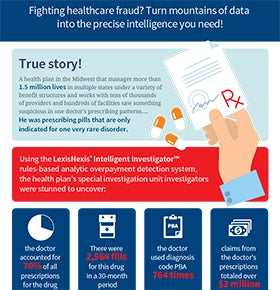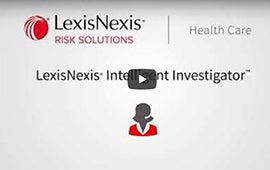A massive goal made meaningful and manageable through connected data
Drive seamless system interoperability and holistic member views
Medicaid Health Initiatives and Interoperability
Maintain a current 360‑degree view of members under the light of SDOH and non‑traditional identity data

Achieve Unprecedented Results
We maintain one of the largest compilations of consumer identity intelligence, covering 95% of the U.S. population — which means we can surface and verify hard-to-find identities that would otherwise require manual verification. And while tools like census data remain static for years, we’re constantly ingesting updates from a variety of data sources — so you’re working with more current, precise information that is directly reflective of your target populations.
Confirm self-reported data and on individuals and organizations
Our referential data is comprised from:
- 84 billion public and proprietary records from more than 10,000 data sources including public records, alternative data, provider and claims data; this includes more coverage of the U.S. unbanked population
- 9 million providers and 1.5 million healthcare organizations
- 40 million businesses uniquely identified with LexIDs® from a universe of more than 4 billion business records
- Sophisticated linking that connects all the dots, assigning our proprietary LexID®️ unique identifier, which accounts for fuzzy matching and resolves identities with over 99% precision
Cultivate additional health insights based on social determinants of health (SDOH)
Our non-traditional identity data helps clinical researchers fill in the non-clinical details of a person that provide deeper, broader context for public health.
- For example, we can provide address history over decades — which provides context into linkages such as hazardous waste sites or poor water quality, or proximity to grocery stores and pharmacies.
- Years of income history may be useful in determining how an individual’s health history trends with their earnings over time.
Our clinically validated, ethically sourced SDOH data takes it steps further, with additional economic and social insights. For instance, better understand how financial stability (in terms of assets and property values) influences access to a broader selection of providers. And the presence or absence of “relatives and associates” data can be an indicator that a person is socially connected or socially isolated.
This data also enables public health researchers to disaggregate outcomes and gain a clearer picture of results by subgroups based on geography, income, social connections and more.
To foster impact in population health, you need the most accurate data and research about community residents. For example, older homeowners may be moving out, replaced by young families who may be wealthier and more educated. If you’re not keeping up with address-based demographics and other identity details, you run the risk of creating programs that don’t reach the intended audiences.
Our consumer data is continuously monitored, and we make more than 80 million record updates each month from public records, internal government databases, credit bureaus and alternative data sources. Dynamic linking assures identities are continuously validated and updated as new data sets and records are ingested. We can also make updates and enhancements via a batch process to align with your agency’s needs.
Can you differentiate one John Smith or Mary Williams from another? Would you be able to determine that John is divorced, and that Mary is newly married? Or that Mary recently moved to your state and is still collecting benefits under her maiden name from her home state 1,400 miles away?
And what about the desire for “Express Lane” authorization? CMS encourages that states increase outreach to new Medicaid enrollees via authorized entities such as healthcare providers, schools and others who can determine presumptive eligibility for services. You can’t be sure all of these parties are viewing the same “source of truth” about these applicants.
That’s where our sophisticated linking technology comes in. We bounce consumer information against our expansive referential database — consisting of 84 billion public and proprietary records from 10,000 sources — and return a unique, persistent identifier, LexID® that resolves to a single individual with 99% precision. By contrast, most agencies are only able to verify against a couple of data points. More sources means a higher veracity of the data and greater confidence in a true match. Not only that, but the data is also cleaner, more connected and normalized for improved interoperability and data sharing. And because LexID® is a non-SSN/non-FEIN identifier, it reinforces patient privacy and data governance.
State Medicaid organizations oversee multiple MCOs, each with their own technologies, databases, data management practices and contracted agreements. This can make consistent oversight difficult and impedes full state-wide visibility. As a result, program management activities are slower and more resource-intensive, and analysis and insights less clear/confident. Especially without access to all the data.
Whether you’re concerned with increasing equitable access to providers, improving user experiences, monitoring health trends or reducing risk in decision making, our identity solutions turn data into actionable insight:
- Get a full view of providers, including practice locations and specialties, to ensure equitable access to health care for members.
- Create consistent, streamlined beneficiary and provider experiences built from a comprehensive, connected picture of patients and providers across databases, programs, channels, devices and geographies.
- Promote data-sharing with strong data governance and security via LexID® ⏤ a non-SSN and non-FEIN dependent identifier.
- Capture insight and isolate trends within program populations by leveraging our big data capabilities, LexID® unique identifier and high-performance computing.
- Improve risk decision-making and appropriate step-up measures by ensuring the underlying identity data driving those decisions is current, complete and connected.
Insights & Resources
Government Product Index
-
AmplifyID™ Identity Risk Navigator
Get a clear view of your program’s participants to pinpoint fraudsters and stop improper payments.
-
AmplifyID™ Master Person Index
Ensure equitable access and smooth service delivery with a precise, whole-person view
-
Instant Verify
Verify IDs and professional credentials instantly
-
Multi-Factor Authentication for Healthcare
Authenticate members and providers
-
Provider Integrity Scan
Know your providers, reduce risk, and prevent fraud.
-
InstantID® Q&A
Authenticate customer identities in real-time






